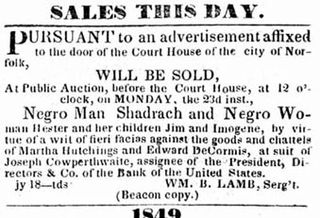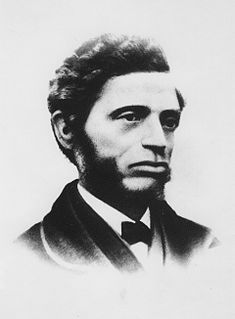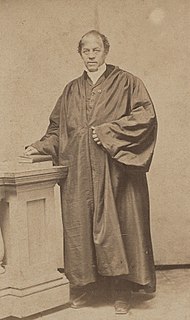Related Research Articles

Edward "Ned" Needles Hallowell was an officer in the Union Army in the duration of the American Civil War, commanding the 54th Massachusetts Volunteer Infantry following the death of Colonel Robert Gould Shaw at the Second Battle of Fort Wagner in 1863.

Henry Alexander Scammell Dearborn was an American soldier, lawyer, author, and statesman. Dearborn was the first President of the Massachusetts Horticultural Society, a member of the Society of the Cincinnati, and the author of many books.

Peter Salem was an African-American from Massachusetts who served as a U.S. soldier in the American Revolutionary War. Born into slavery in Framingham, he was freed by a later master, Major Lawson Buckminster, to serve in the local militia. He then enlisted in the Continental Army, serving for nearly five years during the war. Afterwards, he married and worked as a cane weaver. A monument was erected to him in the late 19th century at his grave in Framingham.

The Boston African American National Historic Site, in the heart of Boston, Massachusetts's Beacon Hill neighborhood, interprets 15 pre-Civil War structures relating to the history of Boston's 19th-century African-American community, connected by the Black Heritage Trail. These include the 1806 African Meeting House, the oldest standing black church in the United States.

John Lewis Bates was a lawyer and Republican politician from Massachusetts.

Lewis Hayden escaped slavery in Kentucky with his family and escaped to Canada. He established a school for African Americans before moving to Boston, Massachusetts to aid in the abolition movement. There he became an abolitionist, lecturer, businessman, and politician. Before the American Civil War, he and his wife Harriet Hayden aided numerous fugitive slaves on the Underground Railroad, often sheltering them at their house.

Shadrach Minkins was an African-American fugitive slave from Virginia who escaped in 1850 and reached Boston. He also used the pseudonyms Frederick Wilkins and Frederick Jenkins. He is known for being freed from a courtroom in Boston after being captured by United States marshals under the Fugitive Slave Act of 1850. Members of the Boston Vigilance Committee freed and hid him, helping him get to Canada via the Underground Railroad. Minkins settled in Montreal, where he raised a family. Two men were prosecuted in Boston for helping free him, but they were acquitted by the jury.

Channing Harris Cox was an American Republican politician, lawyer, and businessman from Massachusetts. He served as the 49th Governor of Massachusetts, from 1921 to 1925. He attended Dartmouth College and served as lieutenant governor to Calvin Coolidge, winning election as governor after Coolidge decided to run for vice president. Cox was noted for advancing progressive labor legislation and adjusting administrative law to Massachusetts' changing economy. He was also the first Massachusetts governor to use radio, when he broadcast live from the Eastern States Exposition on September 19, 1921, at the debut of station WBZ in Springfield.
Kwaku Walker Lewis, was an early African-American abolitionist, Freemason, and Mormon elder from Massachusetts. He was an active member of the Underground Railroad and the anti-slavery movement.
Barzillai Lew was an African-American soldier who served with distinction during the American Revolutionary War.

William Cooper Nell was an African-American abolitionist, journalist, publisher, author, and civil servant of Boston, Massachusetts, who worked for the integration of schools and public facilities in the state. Writing for abolitionist newspapers The Liberator and The North Star, he helped publicize the anti-slavery cause. He published the North Star from 1847 to 18xx, moving temporarily to Rochester, New York.

Wellington-Harrington, also known as Area 3, is a neighborhood in Cambridge, Massachusetts. Overlapping with Inman Square and Kendall Square, it is bounded by Hampshire Street and Broadway on the southwest, the Grand Junction railroad tracks on the east, and the Somerville town line on the north.

John Benjamin Henck although educated as a classical scholar and graduating as valedictorian of the Harvard class of 1840 yet, during his career, transitioned to a practicing civil engineer. As an engineering educator, Henck required a strict knowledge of classical literature" and a "thorough and accurate knowledge of science". One of his notable students was Arthur M Wellington, author of The Economic Theory of the Location of Railways.(1877, first edition.)

Charles Turner Torrey was a leading American abolitionist. Although largely lost to historians until recently, Torrey pushed the abolitionist movement to more political and aggressive strategies, including setting up one of the first highly organized lines for the Underground Railroad and personally freeing approximately 400 slaves. Torrey also worked closely with free blacks, thus becoming one of the first to consider them partners. John Brown cited Torrey as one of the three abolitionists he looked to as models for his own efforts.

Leonard Andrew Grimes was an African-American abolitionist and pastor. He served as a conductor of the Underground Railroad, including his efforts to free fugitive slave Anthony Burns captured in accordance with the Fugitive Slave Act of 1850. After the Civil War began, Grimes petitioned for African-American enlistment. He then recruited soldiers for the 54th Regiment Massachusetts Volunteer Infantry.

John J. Smith House was the home of John J. Smith from 1878 to 1893. Smith was an African American abolitionist, Underground Railroad contributor and politician, including three terms as a member of the Massachusetts House of Representatives. He also played a key role in rescuing Shadrach Minkins from federal custody, along with Lewis Hayden and others.

John James Smith was a barber shop owner, abolitionist, a three-term Massachusetts state representative, and one of the first African-American members of the Boston Common Council. A Republican, he served three terms in the Massachusetts House of Representatives. He was born in Richmond Virginia. He took part in the California Gold Rush.

Lewis and Harriet Hayden House was the home of African-American abolitionists who had escaped from slavery in Kentucky; it is located in Beacon Hill, Boston. They maintained the home as a stop on the Underground Railroad, and the Haydens were visited by Harriet Beecher Stowe as research for her book, Uncle Tom's Cabin (1852). Lewis Hayden was an important leader in the African-American community of Boston; in addition, he lectured as an abolitionist and was a member of the Boston Vigilance Committee, which resisted the Fugitive Slave Act of 1850.

Henry O. Wagoner was an abolitionist and civil rights activist in Chicago and Denver. In the 1830s, as a free black man in Maryland, he worked on a farm and worked to free slaves with a loose group of individuals that is known as the Underground Railroad. He left Maryland in 1838 under suspicion for his activities and settled in Illinois and eventually Chicago after spending a few years in Chatham, Ontario. Continuing to work with the Underground Railroad, he was also a typesetter and journalist for radical anti-slavery newspapers before the abolition of slavery in Chicago. Around this time he befriended Frederick Douglass, with whom he would remain close throughout his life. During the American Civil War (1861–1865), he helped recruit black soldiers for Illinois and Massachusetts regiments. After the war, he moved to Denver, where he had spent some time previously. He continued to be a leader in Denver, working to secure blacks the right to vote and equality in education and under the law.

Joshua Bowen Smith (1813–1879) was an abolitionist, conductor on the Underground Railroad and co-founder of the New England Freedom Association, and politician, serving one term as a Massachusetts state legislator. He worked as a caterer in Boston, starting his own business at the age of 36.
References
- 1 2 3 "John J. Fatal: Death of This Colored Citizen at the Age of 88—Once a Member of Cambridge Common Council". Cambridge Chronicle . March 26, 1904.
- 1 2 Snodgrass, Mary Ellen (2015). "Fatal, John J. (1816-1904)". The Underground Railroad: An Encyclopedia of People, Places, and Operations. Routledge. p. 187. ISBN 9781317454168.
- ↑ "John J. Fatal". Cambridge USA.